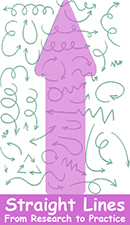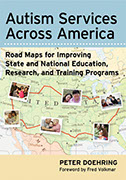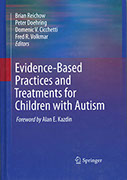ASD Identification
Even though public school programs are mandated by state and federal law to quickly and accurately identify children with ASD and other conditions, ASD continues to be under- and mis-identified in many places across the United States. When I assumed the leadership of DAP, the combination of a cursory protocol, combined with an incomplete and outdated definition of autism in state regulations, made it difficult to differentiate autism from related conditions or to confidently identify ASD in very young children, and impossible to capture the entire spectrum. As a result, the rapid increase in rates of identification in Delaware threatened to overwhelm existing services and lead to a dramatic decrease in program quality.
Key elements
Development of an assessment protocol
We began by implementing a structured assessment protocol that included gold-standard ASD assessments supplemented by classroom observations, that careful considered a broad range of contributing factors, and that relied on the work of a collaborative team led by a school psychologist. We adopted this model in DAP’s main site in 2000, and replicated it across the state through a process of intensive training by independent experts, coaching by the Statewide Director, with the support of detailed documentation (e.g., practice guidelines, evaluation templates, etc.), and with agreements formulated with participating school districts to ensure that they would support this protocol (Doehring and Winterling, 2011, 2013).
Training
I led intensive, multi-day training in ASD classification for more than 85 professionals across 8 school districts, either conducting the training myself or enlisting independent experts. developing all of the associated training materials, and for providing follow-up coaching and consultation. I was also responsible for a program to educate DAP staff, partners, and community partners about these changes to the identification of ASD.
Implementation
Over my career at DAP, I was involved in several hundred assessments for the purpose of the educational classification of ASD, conducting portions of the assessment, or leading or consulting with multidisciplinary teams conducting these assessments.
Updated state regulations
We also updated state regulations pertaining to the educational classification of ASD to be consistent with the recommendations of the consistent with the consensus-based guidelines of the National Research Council (2001). The new state regulations aligned the educational classification criteria with the DSM-IV, expanded it to include Asperger Disorder and PDD-NOS), and defined a rigorous assessment protocol.
Related Content
On this site
 You can only generalize the outcomes reported for a specific intervention or program to other populations if the initial evaluations are comprehensive and accurate
You can only generalize the outcomes reported for a specific intervention or program to other populations if the initial evaluations are comprehensive and accurate
As we established research-based protocols for ASD classification, I gained a greater appreciation for the critical role that accurate identification plays in evaluating claims of effectiveness, especially when considered along with the presence of significant, co-occurring intellectual disabilities and behavioral or mental health conditions. My colleagues and I analyzed ASD outcome research published in 3 different journals, and found wide variations in the likelihood that background information about the level of co-occurring intellectual disability might be reported, or whether an identification protocol was described (Abel et al, 2008): this led us to be more discerning when considering the potential fit between a new practice, and the needs of a particular group of students.
 Reported rates of successful outcomes are skewed when programs exclude students with co-occurring intellectual disability or problem behavior.
Reported rates of successful outcomes are skewed when programs exclude students with co-occurring intellectual disability or problem behavior.
The requests I received to consider adopting other programs prompted me to look closely at the students served by these programs, and I discovered that advocates of these programs did not recognize that they only served a subset of the overall population. Sometimes the exclusion of certain kinds of students was quite explicit; other times it was the consequence of other policies; some programs specifically excluded students with significantly challenging behaviors; some programs adopted curricula that presumed a certain level of ability, and so perhaps unintentionally excluded students with more significant intellectual disabilities. These were important considerations in any recommendation to adopt a program, because they helped us to estimate the proportion of our student population that might benefit. I also found that program advocates did not always recognize that the exclusion of these students should temper the program's claims of success, and so I learned to pay careful attention to these explicit and implicit exclusion criteria.
Current vita
My Presentations and Publications
 With Vince Wintering. (2013). Delaware Autism Program: Statewide Educational Services in the Public Schools. In Autism Services Across America: Roadmaps for Improving State and National Education, Research, and Training Programs. Paul H. Brookes Publishing Co., Baltimore, MD
With Vince Wintering. (2013). Delaware Autism Program: Statewide Educational Services in the Public Schools. In Autism Services Across America: Roadmaps for Improving State and National Education, Research, and Training Programs. Paul H. Brookes Publishing Co., Baltimore, MD
 With Vince Wintering. (2011). The Implementation of Evidence-Based Practices in the Public Schools. In Evidence-Based Practices and Treatments for Children with Autism. (2011). Springer-Verlaug, New York, NY.
With Vince Wintering. (2011). The Implementation of Evidence-Based Practices in the Public Schools. In Evidence-Based Practices and Treatments for Children with Autism. (2011). Springer-Verlaug, New York, NY.
 (2008). A model for regional training and service delivery for children with autism. International Society for Autism Research. London, UK.
(2008). A model for regional training and service delivery for children with autism. International Society for Autism Research. London, UK.
 (2006). Improving the educational classification of autism: Recommendations for school psychologists. National Association of School Psychologists. Anaheim CA.
(2006). Improving the educational classification of autism: Recommendations for school psychologists. National Association of School Psychologists. Anaheim CA.
(2007). Statewide training in the educational classification of ASDs: A model program. National Autism Training and Technical Assistance Programs. Columbus, OH.
 Abel, Jim, Doehring, Peter, Wagner, Brianna, Ruhe Lesko, Leslie, Peters, Kristine, & Myers, Kristin. (2008). Where are the data? Publication profiles of articles on autism in JABA, JADD, and JPBI. Association for Behavior Analysis. Atlanta, GA.
Abel, Jim, Doehring, Peter, Wagner, Brianna, Ruhe Lesko, Leslie, Peters, Kristine, & Myers, Kristin. (2008). Where are the data? Publication profiles of articles on autism in JABA, JADD, and JPBI. Association for Behavior Analysis. Atlanta, GA.
X